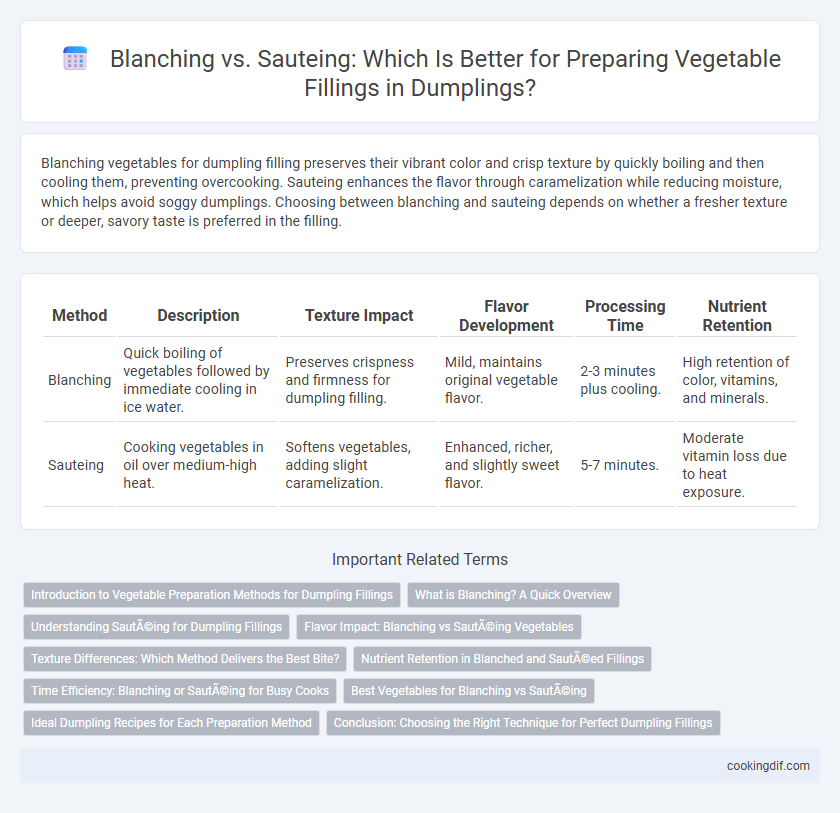Blanching vegetables for dumpling filling preserves their vibrant color and crisp texture by quickly boiling and then cooling them, preventing overcooking. Sauteing enhances the flavor through caramelization while reducing moisture, which helps avoid soggy dumplings. Choosing between blanching and sauteing depends on whether a fresher texture or deeper, savory taste is preferred in the filling.
Table of Comparison
| Method | Description | Texture Impact | Flavor Development | Processing Time | Nutrient Retention |
|---|---|---|---|---|---|
| Blanching | Quick boiling of vegetables followed by immediate cooling in ice water. | Preserves crispness and firmness for dumpling filling. | Mild, maintains original vegetable flavor. | 2-3 minutes plus cooling. | High retention of color, vitamins, and minerals. |
| Sauteing | Cooking vegetables in oil over medium-high heat. | Softens vegetables, adding slight caramelization. | Enhanced, richer, and slightly sweet flavor. | 5-7 minutes. | Moderate vitamin loss due to heat exposure. |
Introduction to Vegetable Preparation Methods for Dumpling Fillings
Blanching vegetables for dumpling fillings involves briefly boiling them to preserve color and texture while reducing bitterness and moisture content, ensuring a balanced filling. Sauteing enhances flavor through caramelization and reduces water content, resulting in a richer and firmer texture ideal for dumplings. Each method influences the moisture level and taste profile of the filling, crucial for achieving the perfect dumpling consistency.
What is Blanching? A Quick Overview
Blanching is a cooking technique where vegetables are briefly boiled in water or steamed, then rapidly cooled in ice water to halt the cooking process. This method preserves the vibrant color, texture, and nutrients of vegetables used in dumpling fillings. Blanching softens the vegetables slightly, making them easier to mix with other ingredients without losing crunch or flavor.
Understanding Sautéing for Dumpling Fillings
Sauteing dumpling filling vegetables enhances their flavor by quickly cooking them in a small amount of oil over medium-high heat, allowing for caramelization and moisture retention. This method preserves the vegetables' texture while intensifying their taste, which is critical for achieving a balanced dumpling filling. Unlike blanching, sauteing reduces excess water and creates a more concentrated, savory profile essential for high-quality dumpling fillings.
Flavor Impact: Blanching vs Sautéing Vegetables
Blanching vegetables for dumpling filling preserves their vibrant color and crisp texture while reducing bitterness, resulting in a mild, fresh flavor that complements other ingredients. Sauteing intensifies the natural sweetness and caramelizes the vegetables, adding depth and richness to the filling with a slightly smoky, savory profile. Choosing between blanching and sauteing significantly alters the vegetable's flavor complexity and moisture content, influencing the overall taste and texture of the dumplings.
Texture Differences: Which Method Delivers the Best Bite?
Blanching vegetables for dumpling filling preserves a crisp-tender texture by briefly boiling and then shocking them in ice water, preventing overcooking and maintaining vibrant color. Sauteing, in contrast, softens vegetables more deeply through direct heat and oil, resulting in a richer, caramelized flavor but a softer bite. For the optimal dumpling filling texture, blanching delivers a more desirable firm bite, enhancing the overall mouthfeel without sogginess.
Nutrient Retention in Blanched and Sautéed Fillings
Blanching vegetables for dumpling fillings preserves water-soluble vitamins like vitamin C and B-complex better than sauteing, which can cause nutrient loss through prolonged heat exposure and oil absorption. The rapid heat treatment in blanching deactivates enzymes that degrade nutrients, maintaining crisp texture and vibrant color. Sauteing, while enhancing flavor through Maillard reactions, often reduces antioxidant levels and heat-sensitive nutrients due to higher temperatures and longer cooking times.
Time Efficiency: Blanching or Sautéing for Busy Cooks
Blanching vegetables for dumpling filling takes only 1 to 3 minutes to cook and helps retain vibrant color and texture, making it ideal for busy cooks needing speed and consistency. Sauteing requires 5 to 7 minutes but delivers deeper flavor through caramelization, though it demands more active attention and time. For maximum time efficiency without sacrificing vegetable quality, blanching is the preferred method in fast-paced kitchen environments.
Best Vegetables for Blanching vs Sautéing
Blanching is ideal for dense, leafy vegetables like spinach, bok choy, and broccoli, preserving their vibrant color and crisp texture while softening them slightly for dumpling fillings. Sauteing suits firmer vegetables such as mushrooms, bell peppers, and onions, enhancing their flavor through gentle caramelization and reducing excess moisture for better filling consistency. Choosing the right method depends on the vegetable's texture and flavor profile to maintain the perfect balance inside dumplings.
Ideal Dumpling Recipes for Each Preparation Method
Blanching vegetables for dumpling fillings preserves their vibrant color and crisp texture, ideal for recipes featuring leafy greens like spinach or bok choy that benefit from slight softening without excess moisture. Sauteing intensifies flavors and reduces excess water, making it perfect for fillings with mushrooms, cabbage, or chives, enhancing their umami and preventing soggy dumplings. Choosing the appropriate preparation method ensures optimal texture and flavor balance in each dumpling recipe, creating a satisfying bite.
Conclusion: Choosing the Right Technique for Perfect Dumpling Fillings
Blanching vegetables for dumpling fillings preserves their vibrant color and crisp texture by briefly cooking them in boiling water, which helps reduce moisture and prevent soggy dumplings. Sauteing enhances flavor through caramelization and allows for better control over seasoning and texture, ideal for fillings needing a richer, more complex profile. For perfect dumpling fillings, blanch vegetables to maintain freshness and moisture balance, or saute when seeking depth of flavor and a tender, well-seasoned mixture.
Blanching vs sautéing for preparing filling vegetables Infographic

 cookingdif.com
cookingdif.com